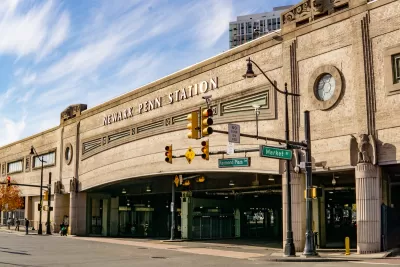The project is primarily funded through federal agencies and will improve a key link between New Jersey and New York City.

The $16 billion Gateway Tunnel project under the Hudson River celebrated the last key piece of funding in the form of a $6.88 billion federal check, reports Colleen Wilson for NorthJersey.com, putting the project ‘past the point of no return.’ Roughly 70 percent of the project is funded through federal dollars.
“Federal, state and local transportation officials came together on a blistering, humid Monday morning to celebrate the occasion of awarding the largest federal grant in U.S. Department of Transportation history for what many have dubbed the most urgent infrastructure project in the country.” The new, two-track rail tunnel will complement repairs to the existing rail tunnel that links Newark, New Jersey to New York City, which suffered damages in Hurricane Sandy that frequently disrupt rail service.
Wilson notes that “While construction has already begun and additional bids are expected to be awarded later this year, the new tunnel is are not expected to be completed until 2035, and the renovation of the older tunnel won't be finished until 2038.”
FULL STORY: Gateway rail tunnel reaches 'point of no return' with $6.9 billion check

Trump Administration Could Effectively End Housing Voucher Program
Federal officials are eyeing major cuts to the Section 8 program that helps millions of low-income households pay rent.

Planetizen Federal Action Tracker
A weekly monitor of how Trump’s orders and actions are impacting planners and planning in America.

Ken Jennings Launches Transit Web Series
The Jeopardy champ wants you to ride public transit.

California Invests Additional $5M in Electric School Buses
The state wants to electrify all of its school bus fleets by 2035.

Austin Launches $2M Homelessness Prevention Fund
A new grant program from the city’s Homeless Strategy Office will fund rental assistance and supportive services.

Alabama School Forestry Initiative Brings Trees to Schoolyards
Trees can improve physical and mental health for students and commnity members.
Urban Design for Planners 1: Software Tools
This six-course series explores essential urban design concepts using open source software and equips planners with the tools they need to participate fully in the urban design process.
Planning for Universal Design
Learn the tools for implementing Universal Design in planning regulations.
Ada County Highway District
Clanton & Associates, Inc.
Jessamine County Fiscal Court
Institute for Housing and Urban Development Studies (IHS)
City of Grandview
Harvard GSD Executive Education
Toledo-Lucas County Plan Commissions
Salt Lake City
NYU Wagner Graduate School of Public Service





























